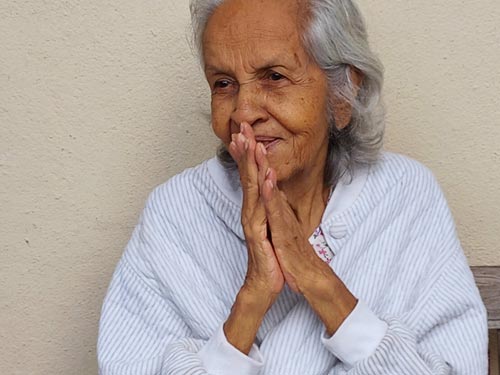All for the love of her beloved trees

A crusader all along: Iranganie Serasinghe. Pic by Prof. Lal Balasuriya
Conservation was always a way of life for Iranganie Serasinghe. It was not a mantle she put on when leading a march of activists and ordinary people to spur some action on an issue that would affect the ecological future of the country. It was integral to who she was and still is– she cares.
She cares about the big issues and the little ones – even just one single tree. She cared enough to lead Ruk Rakaganno – the Tree Society of Sri Lanka, through many a battle in its 50 years of existence and drive its many campaigns with her zeal and spirit. Ruk Rakaganno marks 50 years in 2025.
Once driving her children to school – her two boys then at S. Thomas Prep, she spotted a tree being cut down near St. Bridget’s Convent. It was an ebony tree – one of the last growing on the streets of Colombo and she was horrified that the Municipality would be chopping down such a rare specimen. Stopping her car, she berated the crew. The resulting commotion caused such a traffic jam, Iranganie’s son, Ranjit Serasinghe remembers well his embarrassment (he was still a youngster), and the Mother Superior emerging from the confines of the convent to see what all the fuss was about.
That was Iranganie. Her intervention led to the crew departing that day. Sadly that story did not have a happy ending. The ebony tree survived a few more days but was eventually chopped down.
In the quiet of her home in suburban Kotte on a terrace looking out at a tranquil garden where an Atariya bush is in full bloom, spotting the kingfishers and shikras swooping overhead, Sri Lankan cinema’s most beloved matriarch, is happy to talk of those days when Ruk Rakaganno took root.
Her own deep love for nature was nurtured at home, for she grew up in an estate in the rural surrounds of Ruwanwella. “Actually I was born and bred in a village – so I was very conscious of nature,” she says. That childhood appreciation was further nurtured at Bishop’s College where she went to school. “Bishop’s College had a wonderful garden with wonderful trees. Fantastic trees. Such trees I had not seen before – I wonder if they are still there,” she muses. Her teachers at Bishop’s also contributed to nurturing the students’ love for the outdoors, she remembers and when after she came out of university and there were more people she encountered who were interested in trees, the conversations on conservation became more frequent.
Working as a feature writer and handling the Women’s pages of the Times of Ceylon, Iranganie would often go with that renowned photographer Nihal Fernando and his colleague Pat Dekker on assignment. The idea for Ruk Rakaganno sprouted after conversations with Nihal and Pat, and it was in 1975 that Ruk Rakaganno came into being, those early meetings more gatherings of like-minded conservation minded people who strongly felt that they needed to be vocal and take a stand against some of the potentially disastrous projects that were being initiated.
Vere de Mel of Quickshaws was a great help, she says and would offer her sound advice on operational and financial aspects of getting her fledgling outfit organized into a force to be reckoned with that conservationists and nature lovers could come into. Director of the Dehiwala Zoo, Lyn de Alwis, the cartoonist Wijesoma, artist Laki Senanayake, Dr. T.S.U. de Zylva, a Buddhist monk in Balangoda “who understood what I was trying to say with the name – ‘Ruk kiyanda’ were among the early activists who met at Nihal Fernando’s house at Skelton Road.
The efforts to halt the Sinharaja logging in the 1970’s was one of Ruk Raks’ early campaigns. That the State Timber Corporation’s plan to selectively fell trees within the virgin rainforest to manufacture plywood would have harmed the fragile eco-system was obvious. Many conservation societies like the Wildlife and Nature Protection Society were fighting the battle and Iranganie remembers meeting then Prime Minister Sirimavo Bandaranaike to argue their case and then later, after the 1977 General Elections, the new Prime Minister J.R. Jayewardene. The latter having listened to their views, requested that all the documents on the issue be sent to him. Saner counsel prevailed- the project was halted.
Barbara Sansoni, Dr. Chris Panabokke, Arthur Weerakoon, Prof. Osmund Jayaratne, Channa Ekanayake, Dr. D.B. Sumithraarachchi, W.R.H. Perera, Nirmala de Mel, B.L. Perera and many others, all joined at different times to take up the issues that kept cropping up. There were major campaigns and marches over the years. Iranganie recalls one instance when they marched to Kandy and she was bitten by a monkey at Kadugannawa, which resulted in her having to be taken to hospital for medical attention, though she still cannot figure how it happened.
On another occasion, Ranjit recalls a bullock cart protest through the Fort, Colombo’s bustling commercial district.
It was always trees that mattered, Ranjit adds, recalling how she had been invited to take a teaching post in France. “She had to make the decision whether to go. She looked at the tamarind tree (in front of their house at Araliya Gardens, Nawala) and decided she couldn’t leave the tree!”
The building of the now ‘green’ Kandalama Hotel saw contentious and protracted protests by many conservation societies and members of the public, Ruk Rakaganno among them and Ranjit remembers the time “Amma had walked into Bawa’s office”, very much on the warpath. Channa Daswatte and Bawa’s other staff were holding their breath wondering what would happen, but thankfully it went off without incident. Geoffrey Bawa had been involved in Ruk Raks in earlier times but was now the opponent. All the inputs and pressure by the environmentalists contributed to Kandalama’s many eco-friendly initiatives, he feels.
The campaign against the Eppawala phosphate mining was another major cause that Ruk Raks took up and even after her days of marches and street protests were past, Iranganie continued to work on many projects along with her sister Kamini (Vitharana), and son Ravi. Ravi’s untimely death was a huge loss for her as was Kamini’s passing in 2023.
The memories of those heady days may have faded in parts, but the passion and conviction which led to the birth and growth of Ruk Raks are still very much a part of Iranganie Serasinghe.
| Iranganie is 97 today | |
| Many across the island and in other lands, will be happy to wish her on this day. Apart from her friends, large numbers have known her through the way society seeks the cinema for entertainment and comes away with some meanings of life. Iranganie has had a long enriching connection to society in this relationship with her. So a public birthday greeting takes meaning. Much has been written about Iranganie over the long years of her probably unrivalled contribution in cinema and theatre performance, that a repeat of that story, now archival wealth, is redundant. Here I throw a quick flash or two on what a long friendship has left in me as the heart of Iranganie. “Age shall not wither Nor custom stale” “I want everything of life, Total, complete, Otherwise I reject it.” (As Antigone 1950) -Ernest Macintyre
|
Searching for an ideal partner? Find your soul mate on Hitad.lk, Sri Lanka's favourite marriage proposals page. With Hitad.lk matrimonial advertisements you have access to thousands of ads from potential suitors who are looking for someone just like you.


